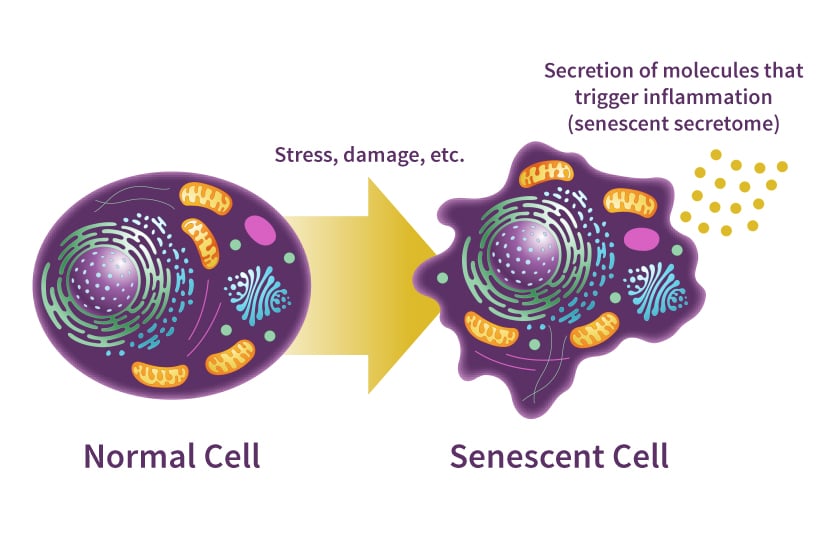One thing I’ve become more interested in as a get older is how to prevent (or at least slow down) many of the common issues athletes face with age.
I’ve talked about a lot of these before, including
(1) the increased importance of strength training for masters runners;
(2) how nutrition needs to change as we age;
(3) how to reduce your injury-risk in training.
But, one emerging topic I haven’t yet talked about in the field of anti-aging research is senolytics—a class of compounds that selectively target and eliminate senescent cells in the body.
Senolytic supplements have recently gained attention for their potential to combat age-related health issues and improve physical performance, offering intriguing possibilities for aging individuals and even athletes seeking to maintain peak performance as they age.
But, what are they and what does the research have to say? Well, that’s what I set out to explore myself.
In this article, we will delve into the research on…
- What exactly senolytics are and how they work
- The research on potential benefits for age-related health issues
- The current literature on how they may help improve athletic performance
- And an examination what more is needed
What Are Senolytics?
Senolytics are a category of compounds designed to eliminate senescent cells from the body.
Senescent cells, also known as “zombie cells,” are damaged or dysfunctional cells that stop dividing but do not undergo programmed cell death (apoptosis).
As we age, these senescent cells accumulate in various tissues, contributing to inflammation and the development of age-related diseases such as cardiovascular disease, neurodegenerative disorders, and osteoarthritis.

The presence of senescent cells is thought to disrupt the healthy functioning of tissues and organs, leading to a decline in overall health and resilience.
By removing these cells, senolytics aim to rejuvenate tissues, reduce inflammation, and potentially reverse some aspects of aging.
How Senolytics Work
Senolytic compounds target pathways that help senescent cells survive.
These cells rely on various survival mechanisms, such as increased expression of anti-apoptotic proteins, to avoid being eliminated.
Senolytics work by inhibiting these survival pathways, thereby triggering apoptosis in the senescent cells without affecting healthy cells.
Several naturally occurring and synthetic senolytic compounds have been identified. Some of the most researched senolytics include:
- Quercetin: A plant flavonoid found in apples, onions, and tea.
- Dasatinib: A chemotherapy drug that has shown potential as a senolytic.
- Fisetin: Another flavonoid, abundant in fruits like strawberries.
- Navitoclax: A drug that inhibits anti-apoptotic proteins and has shown senolytic effects.
Potential Benefits of Senolytics
Reducing Age-Related Inflammation
One of the hallmarks of aging is the chronic low-grade inflammation known as “inflammaging.”
Senescent cells secrete pro-inflammatory cytokines, chemokines, and other factors collectively known as the senescence-associated secretory phenotype (SASP).
This inflammatory environment can lead to tissue damage and the progression of various age-related diseases, including cardiovascular diseases and neurodegenerative disorders.
In a study published in Nature Medicine, researchers found that senolytic treatments in aged mice led to a reduction in systemic inflammation and an improvement in physical function.
The study concluded that by clearing senescent cells, senolytics could mitigate inflammaging and improve tissue health .
Improving Cardiovascular Health
Cardiovascular diseases are the leading cause of death globally, and aging is one of the most significant risk factors.
Luckily, as runners we’re already doing a lot to combat many of the common contributors to cardiovascular disease, such as obesity and not enough exercise.
That said, I know plenty of lifelong runners that have suffered from cardiovascular issues, so running alone isn’t a guaranteed solution.
In this case, senolytics have shown some promise since the buildup of senescent cells in the vascular system can contribute to arterial stiffness, atherosclerosis, and high blood pressure, which increases the risk of heart disease and stroke.
As an example, research published in Aging Cell demonstrated that senolytic treatments using a combination of Dasatinib and Quercetin in aged mice improved vascular function by reducing senescent cell burden in the arteries.
These findings suggest that senolytics may help maintain vascular elasticity and reduce the risk of cardiovascular diseases in older individuals.
Promoting Longevity and Healthy Aging
Perhaps the most exciting potential benefit of senolytics is their ability to promote longevity.
By clearing senescent cells, senolytics may help delay the onset of age-related diseases and improve overall healthspan—the period of life spent in good health.
In a landmark study published in Nature Medicine, researchers demonstrated that senolytic compounds extended the lifespan of aged mice and improved their overall health.
The study found that treated mice exhibited better physical function, reduced disease burden, and enhanced resilience to stressors compared to untreated mice.
While more research is needed to confirm these effects in humans, these findings suggest that senolytics could be a key tool in promoting longevity.
Enhancing Muscle Function and Physical Performance
While the intention of this article is to focus mostly on health, I know personally that I’m not letting age be an excuse for why I can’t perform as well I want (or at least I think I can).
One thing we know for sure from the research, and we’ve written on extensively, is that as we age one of the first things to decline is muscle mass and strength.
And while I’ve already mentioned the need to include more strength work as you get older, there are some things we may be able to do at the cellular level that can help as well.
In a study published in Nature Communications, researchers treated aged mice with senolytics and observed significant improvements in muscle function.
The removal of senescent cells enhanced muscle regeneration and reduced inflammation, resulting in stronger, more resilient muscles.
For aging athletes, this could translate into sustained muscle strength and improved physical performance.
Senescent cells accumulate in muscle tissue, contributing to this deterioration by promoting inflammation and reducing the ability of muscle cells to regenerate.
In addition to strength and performance, there is some research that senolytics can also aid in recovery, especially from injury.
A study in cell reports found that senolytics enhanced exercise capacity and recovery time in aged animals, suggesting that these compounds could offer similar benefits for older athletes.
The authors posit that this is due to senolytics helping to mitigate these effects by improving the cells ability to regenerate muscle reduce inflammation, and enhance tissue repair.
Finally, a recent double-blind, placebo-controlled clinical trial of Qualia Senolytic revealed significant improvements in joint health, which is crucial for athletic performance.
The study showed a remarkable 68% reduction in joint discomfort, allowing for greater mobility and reduced pain during physical activities.
Participants also experienced enhancements in physical function, including better flexibility and ease in performing daily tasks—key factors that can translate to improved performance in sports.
Additionally, the trial used the Rand SF-36 Quality of Life Metrics, showing notable gains in physical functioning, energy levels, and overall well-being.
These improvements suggest that athletes could experience not only less discomfort but also more stamina and energy, leading to enhanced endurance and recovery during training and competition.
Are senolytics magic? Should you try them?
Senolytics definitely represent a promising new frontier in the battle to improve and maintain health and athletic performance as we get older.
However, while the research on senolytics is compelling, much of the work has been conducted in animal models, and more studies are needed to confirm their efficacy in humans.
I was first introduced to them through one of our long-term partners, Qualia.
I’ve been using their Qualia Mind product on my own for well over a year and when I mentioned I was interested in ways to maintain my performance as I push my mid-40s they showed me some of the research on senoyltics.
I’ve been impressed so far in the 3 months since I’ve started using them. I’ve felt more recovered, despite being in the midst of marathon training and I have more energy throughout the day.
If you’re interested in giving them a try, head over to https://qualialife.com/rttt15 to check out the research for yourself.
The reason I chose Qualia Senoylytic specifically is they are committed to fully transparent formulas (a huge must for me), they focus on ingredients with cited research (and actually cite it), and you only need to take it for two days every month.
Overall, senolytics offer exciting potential for improving health and athletic performance as we get older. I’ll continue to monitor the research as well as my own use, but the possibilities are intriguing.




